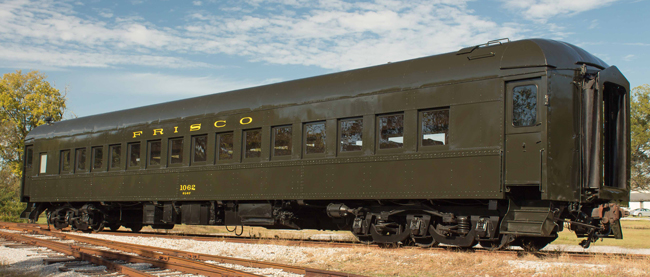
In September of 1910, the American Car & Foundry Company completed construction of No. 1062, one of twelve 60-seat coaches numbered No. 1052 through No. 1063, lot No. 5522. The new cars were built for the St. Louis - San Francisco Railway (SLSF), better known as Frisco Lines. The new all-steel construction coach was a type of passenger car which would be known as a heavyweight car. Heavyweight cars had a steel frame, sides, and roof and thus rode more smoothly than earlier wooden coaches with truss-rod bracing. The brand-new No. 1062 offered Frisco passengers the latest in coach passenger comfort.
Clerestory Roof
As originally built, the No. 1062 had a clerestory roof, and, like all passenger cars of its day, was not air-conditioned. The car rode on 6-wheel trucks with 36” diameter wheels and 5x9” journals. The width over side sills was 10’ 3”, and the length over end sills was 70’ 1”. Total length over buffers was 79’ 6 ¾”. Truck centers were 54’ 1”, and the total wheelbase was 65’ 1”. Overall height over ventilators was 14’ 6”.
Midwest Routes
For the next 32 years, No. 1062 carried Frisco passengers over the midwest railroad’s routes through the states of Missouri, Kansas, Arkansas, Oklahoma, Texas, Tennessee, Mississippi and Alabama. Major cities served by Frisco included St. Louis, Kansas City, Springfield, Memphis, Tulsa, Ft. Smith, Oklahoma City, Dallas, Ft. Worth, Birmingham and Mobile.
The Firefly

The Firefly averaged 52.3 miles per hour over its 379-mile route.
Modernization
In April and May of 1942, 60-seat coach No. 1062 was modernized in the Springfield shops for operation in the Firefly’s consist. New seats, lighting, and an air-conditioning system was added. The addition of air-conditioning changed the appearance of the car, as a new turtleback roof replaced the original clerestory roof to accommodate for air ductwork in the ceiling. Mounted underneath the car was a Waukesha Ice Engine, which was a refrigeration system utilizing a compressor supplemented with a water chiller powered by a propane engine. Skirting was added to make the car appear more streamlined, and the blue and silver paint scheme was applied.
Frisco advertised the modernized heavyweight cars in the Firefly consist as “heavier than ordinary streamliners ... resulting in smoother riding.”
Information on the No. 1062’s service in later years is unavailable. It is probable that the car saw service on a number of Frisco trains during the 1950s and 1960s. By the late 1960s, the car wore a plain Pullman Green paint scheme as it does today. At some point, the streamliner skirts were removed, most likely to allow for easier maintenance.
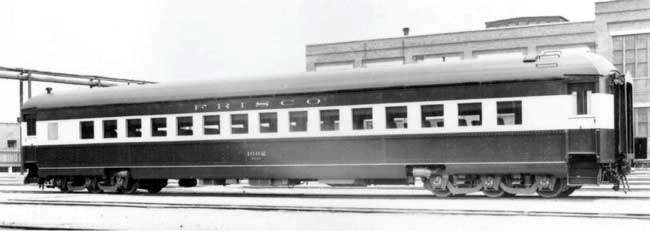
1062 as it appeared April 30, 1942 after being rebuilt for service on the Firefly streamliner. Note the addition of skirting. The original clerestory roof has been replaced by a turtle-back roof to accommodate ductwork for the newly installed air conditioning. The car was painted dark blue with a silver window band.
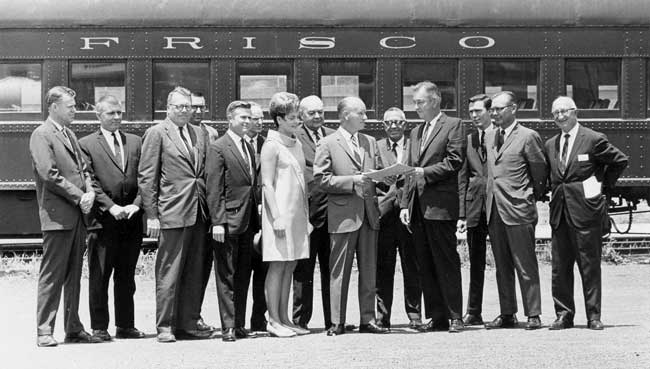
The presentation of Frisco Coach No. 1062, by Frisco Railway, May 24, 1968.
(L-R) SCL RR Charles L. Hill, Frisco RR Bill Byrd, HOD W.A. Boone, W & M James Dickey, SCL RR E.L. Hobbs, W&T James C. Henderson, Miss Transportation Week 1968 Linda Walls, Asst. Dist. Mgr. Frisco RR Clifford Hall, Sales Mgr. Frisco RR G.J. McGarity, SCL RR W.L. Petrie, President HOD George Sitten, SCL RR Dave Nichols, SCL RR Morgan Gresham, HOD Don Christie.
*SCL: Seaboard Coastline Railway
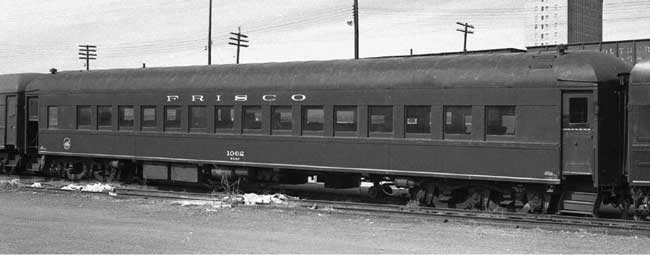
No. 1062 wore a plain Pullman Green paint scheme in the 1960s as shown in the view of the Frisco coach at the Heart of Dixie’s Powell Ave. location in Birmingham. The streamline skirting had been removed.
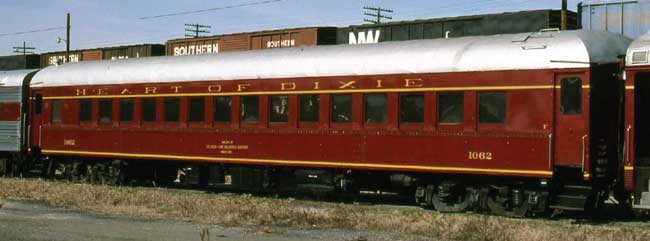
In 1985 HOD volunteers repainted No. 1062 in metallic burgundy with gold striping and lettering, completing a restoration of the car that required several years of volunteer effort. The interior was completely refurbished with new paint, flooring, and upholstery. The car was the pride of the Heart of Dixie.
The Ban on Friction Bearings
The No. 1062 spent her first years with the Heart of Dixie Railroad Museum operating on mainline excursion trains. During the last years of mainline service, the car required several modifications to keep it in operation. The original UC brake valve was replaced with modern ABDW brakes. After a derailment, involving a NS excursion train, tightlock couplers became a requirement on all equipment operating in mainline excursion service and were dutifully installed on No. 1062.
The final blow to operating the car came when railroads began to ban friction bearings. The No. 1062 became one of the last friction-bearing passenger cars to operate on CSX or NS lines when it made a weeklong journey across the State of Alabama on the Alabama Reunion Special in May and June of 1989. The Frisco coach was the coolest and smoothest-riding car in the whole train, much to the pride of the Heart of Dixie Railroad Museum's crew.
In Service for Over 100 Years
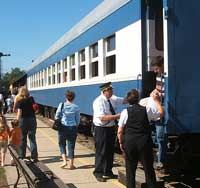
When the Heart of Dixie Railroad Museum began operations on the Calera & Shelby Railroad in the fall of 1994, the No. 1062 returned to duty in regular passenger service, although as an open-window coach. The Waukesha Ice Engine was considered to be impractical to operate under current conditions. In recent years the windows and upholstery were replaced. The No. 1062 has now been hauling passengers for over 100 years. One wonders how many passenger miles the car has accumulated over its long life: 57 of those years for the Frisco and over 43 more with the Heart of Dixie Railroad Museum. It is hoped that the car will be maintained and continue to operate and tell its story well into the 21st Century. With proper care, perhaps the car will someday celebrate its second centennial!


